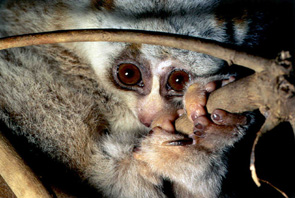Status: Schedule 1
 Four (4) subspecies (disputed) distributed throughout South-east Asia, China, India and Indonesia (from Vietnam to Borneo). Within India, found in all the seven states
of north-east India. The north-western limit of its range is the southward band of the river Brahmaputra. According to CITES II rating this species is at lower risk. Jhumming/Deforestation, even moderate selective logging affects their numbers adversely. Hunted
for food, medicine and religious ceremony.
Four (4) subspecies (disputed) distributed throughout South-east Asia, China, India and Indonesia (from Vietnam to Borneo). Within India, found in all the seven states
of north-east India. The north-western limit of its range is the southward band of the river Brahmaputra. According to CITES II rating this species is at lower risk. Jhumming/Deforestation, even moderate selective logging affects their numbers adversely. Hunted
for food, medicine and religious ceremony.
ECOSYSTEM USED
Subtropical and tropical moist forests upto 1300 m. Slow loris is arboreal in nature and only inhabits the thickest of vegetation in the tropical evergreen forests. It prefers
the regenerating forests and occupies the lower canopy. Also reported from the sub-urban gardens, secondary growths and scrubs. Slow loris prefers forest edges in and around tropical evergreen forests. The edges provide them more support and prey base. ( Pic
of Asian slow loris, taken in Laos, courtesy -www.kostich.com)
REARING
Birth season: When vegetation is at a maximum level. Mothers carry infants upto six (6) months. Sexual maturity reaches at the age of 17-21 and 17-20 months for females and
males, respectively. Birth interval varies from 12 to 18 months. Infants are parked while mother forages.
FEEDING
Slow lorises are cryptic, slow-moving animals who forage alone throughout the night. The male loris’s range may be larger than the female’s. It is nocturnal, arboreal and hang
from a branch upside down to eat with both hands. Their diet include the fruit (50%), animal prey (30%), gum (10%), shoots, bird eggs and insects that have a repugnant taste and smell. Leaves are not consumed but the sap from leaf petiole is sucked. Preferred
food plant species recorded is Dillenia pentagyna.
REFERENCES
Rowe (1996), Shrivastava (1999).